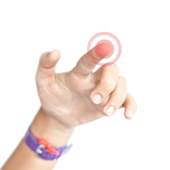• Represent the objects in recognizable way.
• Design for direct manipulation with the objects on screen. Reduce the number of objects kept hidden.
• Nails do not work for fewer touch screens, such as capacitive touch screens. Though they are more accurate than finger pad and fingertip, but in some touch screens, they may not trigger the touch event. Appropriate care should be taken while choosing the type of touch screen, especially when the target users are female.
• Typing on touch screen can be tedious and straining for wrist, especially on vertica mounted touch screens for a longer period of use. The arrangement of a keyboard may make the task of typing easier.
• Also, the height of vertically mounted, wall mounted and large size touch screens should be properly chosen to make the system easy to use. Users should not struggle (bend too much or jump) to reach the information.
• Human palm is accidentally touched to the screen, activating other elements on the interface. One solution is to make a vertical arrangement for the touch screen, which may work for interactive kiosks, but not for mobile phones.
• In an open environment used touch screens (e.g. used for city guides, bus information system at bus stops etc.) the screen get dirty due to the environment. Appropriate care should be taken to choose the type of touch screen, casing if required, and placement of contents /actionable objects.
• During the touch screen use, the hand covers to significant space of the screen, which is not visible. Try not to put instructions, labels, and contents below the interface element that can be touched.
• Mouse based gestures may not be suitable for touch interfaces. Natural gestures are best way to think of using new gestures for touch interfaces.
• There are environmental challenges while designing touch screen interfaces. In cold weather, people tend to wear gloves, which may require interface modifications and type of touch screen to be used.
• The aim of touch screen interfaces should be for direct manipulation. This makes interface direct and easy to understand. If haptic feedback is not possible to accommodate, try using several iterations of visual and sound feedback. (e.g. visual bounce, color change, increase and decrease icon size, animation of one screen moving to another screen, beep sound etc.).
• There is no hover in touch-based interfaces. It is a good idea to tell people how to touch and where to touch. Another way of looking at it is, actionable objects can be designed (size, color, shape etc.) to attract users to touch.
• The touch screen interface aims at direct manipulation. Try to avoid hidden contents.
• It can be beneficial to use a grid structure to divide the screen and provide content appropriately. E.g. the content structure on screen can be divided into display elements, input elements, keyboard section, and status display.
• Location of the structured content grid is beneficial to keep consistent for easy usage. Similar way, touch feedback can also be made consistent throughout the interface. This will help users to perceive them as unity.
• Limit the number of total screens to a smaller number.
• Input data entry such as a keyboard or numeric entry can be made available whenever required. It needs not to be all the time on the screen, especially for a longer period of use.
• It is recommended to use graphical buttons (of course, that should look like a button) to perform an action instead of using a text-based link. Though if the screen space is relatively smaller and completely character based, then text-based links can be used.
• It is recommended not to show cursor on the touch screen interfaces.
• There are two ways to have numeric entry arrangement.
• Telephone layout
• Keyboard layout
Telephone layout can be useful for users as they can relate the numeric entry with other existing telephones. Especially when numeric entry is designed for calling purposes.
Keyboard layout can be useful for user who is known to use keyboard and its numeric layout, though it may not be a good idea to accommodate the same calling purpose.
Positively, It provides an opportunity for designers to brainstorm natural gestures that can be used for touch-based systems. If the target size of the element is small, finger precision can be a worry and be less accurate.

